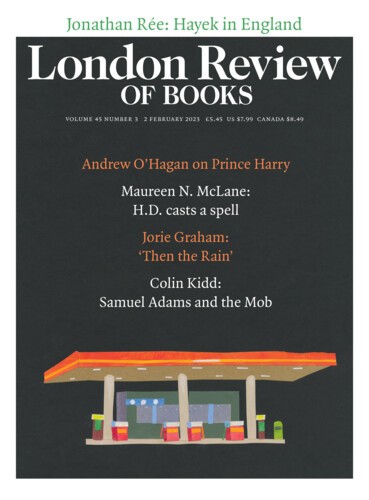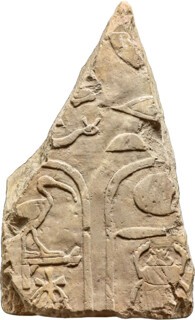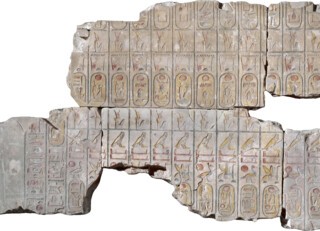In the end , it was as simple as ‘L is for lion’, or rather, ‘lion is for L.’ The rivalrous Egyptocryptologists of the British Regency and the Bourbon Restoration knew that the name in the pharaonic cartouche on the Rosetta Stone in some way stood for Ptolemy (V); the Greek inscription celebrated the boy-king’s accession and offered him special honours in Egyptian temples on the anniversary of his coronation and his birth. The recumbent lion 𓃭 was the fourth sign in the hieroglyphic inscription corresponding to Ptolemaios and the second character in the name Cleopatra found on a Greek/hieroglyphic inscription on an obelisk from Philae, carted off to Kingston Lacy in 1830. It eventually became obvious that these particular hieroglyphs did not represent words or ideas but simply sounds. The possibility remained, however, that this was a kind of hieroglyphic katakana reserved for foreign (i.e. Greek) words. Indeed, Champollion titled his famous letter to M. Dacier of September 1822, the bicentennial of which is the occasion for the British Museum’s current exhibition (until 19 February), ‘on the Alphabet of Phonetic Hieroglyphs Used by the Egyptians to Inscribe on their Monuments the Titles, Names and Epithets of Greek and Roman Rulers’.
This in itself was not necessarily big news. The Swedish diplomat Johann David Åkerblad had already correctly deduced the signs for P and T in the hieroglyphic version of Ptolemy, suggesting that the lion stood for LO; the next, which looks like the front of a Eurostar train, for M; while in 1819 the British polymath Thomas Young thought the lion stood for OLE; the Eurostar for MA; the two feathers for I; and the bent line, probably a fold of cloth, for OS: ‘Thus we have precisely PTOLEMAIOS.’
What Champollion did was unsheathe Occam’s razor, dispense with syllabograms and apply the principles of the suggested alphabet to a much larger list of Greek and Roman royal names, testing the results against one another. Young had decided for some complicated reason that the third character of Ptolemy’s cartouche was to be ignored. Champollion thought this ‘flower with a bent stem’ (in fact a lasso) must simply stand for O. The lion therefore need represent nothing more than L, the Eurostar M, the two feathers EE, and the fold of cloth S, giving PTOLMEES. KLEOPATRA shared many of the same letters, including the lasso for O, but added K, R and A as well as a different glyph for T. ‘Alexander the Great’ inscribed on the temple of Luxor gave Champollion N: ALKSENTRS.
From here, he revealed numerous additional names and titles, including KEESRS (Caesar), a frequent element of Roman imperial titles. This much larger sample of hieroglyphic letters allowed Champollion to discover a number of important principles: that the same Greek letter might be represented by more than one glyph; that instead of syllabograms, short or unstressed vowels were often simply omitted; that L was often written for R (according to his phonetic alphabet Caesar was indiscriminately KEESRS or KEESLS), T for D, K for G and vice versa. It followed, then, that the phonetic hieroglyphic alphabet was not designed to render Greek or any other foreign words, but seemed to use a pre-existing phonetic alphabet and a pre-existing tendency in the use of that alphabet often to ignore vowels. Therefore, he concluded, in a sentence towards the end of his letter: ‘I am certain that the same hieroglyphic-phonetic signs used to represent the sounds of Greek and Roman names are also used in ideographic texts inscribed long before the arrival of the Greeks in Egypt, and that they already had, on certain occasions, the same representative value of sounds or articulations as in the cartouches inscribed under the Greeks and Romans.’ He made good his point two years later in his Précis du système hiéroglyphique des anciens Égyptiens, which is the true starting point of modern Egyptology.
Here we need to acknowledge a curious little byway on the path to decipherment, for sitting in the audience as Champollion’s letter was published to the Académie royale des Inscriptions et Belles-Lettres was our polymath Thomas Young. Pliny the Elder had heard of a pharaoh called ‘Rhamsesis’ who raised one of the biggest obelisks in Egypt, tying his own son to the top so that the workers were careful not to let it fall during its erection. In his 1819 article on Egypt for the Encyclopaedia Britannica, Young juxtaposed Pliny’s information with some very ancient cartouches, arguing that if the circle with a dot in those inscriptions was the sun 𓇳 (RE in Coptic, the pre-Arabic language of Egypt), and the strange spidery M-shape 𓄟, like three feather boas tied together, meant ‘birth’ (MES in Coptic) and the third sign represented a pair (SHESH in Coptic), you would have a pre-Greek cartouche which ‘we may venture to call … Remesses’. On the first, second and last points he was correct. If Young had more insistently observed that the third sign in the cartouche of Ramesses included the very same bent line – the fold of cloth – he had transliterated as OS in ‘Ptolemaios’ in the very same article, and had wondered a little more about the implications of that observation, he might have reached the same conclusion that Champollion announced three years later.
Champollion’s first demonstration of a native pre-Greek phonetic system was precisely his decipherment of the cartouche of Ramesses, soon followed by that of Thutmose, which had the ibis – the god Thoth – instead of the sun preceding the feather boas (Thoth/Born). This slightly odd parallelism between the work of Champollion and Young led to some bitterness on the part of the British, although it is clear that Champollion’s immersion in Coptic and his broader knowledge of hieroglyphic inscriptions allowed him to make much greater and more firmly founded advances. Young at least remained on speaking terms with his younger rival.
The key to unlocking hieroglyphs may have been as simple as ‘lion is for L’ but the writing system Champollion revealed in 1824 was extraordinarily complicated, or at any rate befuddling, full as it was of pleonasm, alternates and excess. There were, it turned out, more than eight hundred hieroglyphs and they came in three flavours: phonetic signs that spelled out sounds; ideograms that indicated things; and determinatives that added useful unspoken information about the theme – whether, for instance, an action, a god or a place was being spoken of. Unfortunately, a single sign such as the seated man 𓀀 might represent a sound or a thing or a theme.
The second source of difficulty was that different phonetic signs could represent one letter, two letters, or three or more letters, so that although the uniliteral letters, the ‘alphabet’ of 24 sounds, including three varieties of ‘h’, could have written everything necessary, the Egyptians had an additional system of biliterals to represent combinations of two of those sounds and triliterals to designate combinations of three. The final complication was that despite all these hundreds of available signs, the ancient Egyptians used very few of them for vowels, giving us in most cases just the consonantal skeleton of any individual word. This is not very different from scripts used for other languages of the Afro-Asiatic family, but unlike with those living languages, we can only guess at the vowels lost from ancient Egyptian. Egyptologists usually just insert a generic ‘e’.
The British Museum exhibition investigates the decipherment of Egyptian hieroglyphs step-by-step, following all the attempts, the transcriptions, the blind alleys and the ultimate revelation in close detail. When I visited on a Monday lunchtime, it was full of interested parties crowding around the illuminated glass cases of inscriptions, letters and notebooks, all of us trying to work out the distinction between hieroglyphic, hieratic and demotic versions of ancient Egyptian or between Sahidic and Bohairic dialects of Coptic alongside the rivalrous Egyptocryptologists of two hundred years ago.
What took them so long? For more than five hundred years, Greeks lived alongside Egyptian priests who knew how to write in the ancient script preserved for monuments (‘hieroglyphs’ means ‘sacred carvings’); indeed, Greek pharaohs – the Ptolemies – often paid them richly to do so. The great tourist attractions of Philae, Edfu, Esna, Dendera and Kom Ombo were sponsored not by Egyptians of the Old, Middle or New Kingdoms, but by Greek kings or Roman emperors of the first centuries bc and AD, and covered with their hieroglyphic commissions, while even such super-ancient, properly Egyptian temples as Luxor and Karnak owe something to the embellishments of Alexander and his short-lived successor Philip Arrhidaeus, neither of whom ever visited but who, from a distance, were much more concerned than the Egyptians’ previous foreign overlords, the Persians, to graft themselves onto the pharaonic chain.
The early Ptolemies, whose territories included most of Palestine, were very curious about the ancient peoples over whom they had acquired sovereignty. The earliest text of the Hebrew Bible, the Septuagint (LXX to its friends), is in Greek. It was said to have been produced by seventy – septuaginta – Hebrew scholars (72, to be precise) who each came up with identical versions: the first totally perfect translation. The Ptolemies were similarly said to have commissioned an Egyptian priest, Manetho, to produce a history of Egypt, an epitome of which provided Josephus with his lists of Egyptian dynasties and the names of long forgotten pharaohs such as Ramesses and Thutmose, sourced from king lists sculpted on temples or written on papyri.
Every now and again this understanding of the written language of a people who lived alongside the Greeks and Romans for centuries seems to find its way into Greek and Roman discourse. So Pliny the Elder in his little commentary on obelisks states that ‘those sculptures and images that we see are Egyptian letters’ (‘etenim scalpturae illae effigiesque quas videmus aegyptiae sunt litterae’). Plutarch even mentions that there were 25 Egyptian letters. But these hints at the truth, if such they were, were lost amid the general assumption of mystical esoteric symbolism.
In 1419, for instance, an agent of the Medici bought an ancient manuscript by one Horapollo entitled Hieroglyphica, written around 400 AD and discovered on the island of Andros. It claimed to reveal the meaning of 189 hieroglyphs and it did correctly reveal the meaning of quite a few, but always in terms of what they symbolised rather than the words they represented. If ever you find yourself in an Egyptian temple, look for a cartouche under the figures of a sun 𓇳 and a goose (or pin-tail duck) 𓅭; this means ‘Son of Ra’ and is where you will find the familiar name – as opposed to the several official but unfamiliar names – of the relevant pharaoh, whether Ramesses, Thutmose, Alexander, Cleopatra or Ptolemy. Horapollo correctly translated the goose-sign as ‘son’, but he reasoned that this was because the goose is exceptionally devoted to its offspring. In fact, the image of the goose has absolutely nothing to do with goosiness; it simply represented the sound sa, ‘son’.
In her 1965 monograph Le Débat sur les écritures et l’hiéroglyphe aux XVIIe et XVIIIe siècles, Madeleine David put a name to the problem: ‘le préjugé hiéroglyphiste’ or ‘the hieroglyphist prejudice’. The phrase was quickly borrowed by Jacques Derrida in his review of the volume, which formed one of the chapters in Of Grammatology. This prejudice, he argued, produced an aveuglement intéressé, a ‘blindness with intent’. In the first place this meant that a beautiful representation of a reclining lion could not be a mere L-sound, that the random non-representational Saussurean system of signs should not simply be abstract and non-representational – a network of the mere differences between Ps and Qs and Ps and Bs – but should look abstract and non-representational, although, as Champollion knew well, it was only when the Greeks borrowed their letters from the Phoenicians that a proper disassociation between letters and things was achieved. The Phoenicians, too, had used an acrophonic system and their letters had once been representative: aleph (‘ox’) for A, 𐤀; lamed (‘goad’) for L, 𐤋. But ‘alpha’ and ‘lambda’ mean nothing in Greek except as names for the letters.
As Derrida noted, this occlusion took the form not so much of an ethnocentric misunderstanding as of an ‘admiration hyperbolique’. As a super-ancient, even an originary human civilisation, as the first inventors of writing, the ancient Egyptians had used signs to communicate Platonic ideas and cosmic truths without the mediation of mere logoi – of spelled-out, sounded-out words. In parallel with this exaltation went more commonplace negative stereotypes of the Egyptian priests jealously guarding secrets, of dark hidden things of magic.
There is, therefore, along with the thrill of suddenly being able to understand these miles and miles of ancient texts, a certain disappointment that, after all, a lion just means L. But that is also a misunderstanding. In ancient Egyptian culture, images and words were in a state of constant oscillation between letters, sounds and things. Hieroglyphic letters require as much typographical standardisation as the letters of any alphabet in order to be read. What makes a beautiful image of an owl into a beautiful calligraphic letter M is rigorous formal regularisation; a perched bird turning its gaze directly towards you 𓅓. You might see hundreds of these owls in a royal tomb and there will be not the slightest variation between them. Similarly, the hieroglyph of the bee – ‘bjt’, ‘bee’, ‘honey’ – is always in exactly the same posture 𓆤 and is found above cartouches containing the regnal as opposed to the familiar name of the pharaoh. When a man is shown next to a hive and a swarm of bees, all depicted in the precise typographic form, are they bees or the word ‘bee’ or ‘honey’ spelled out multiple times? And what about the ankh itself, often seen being placed into the mouth of a pharaoh by a god? This was apparently a phonetic triliteral anh derived from the sign of a sandal strap. So is the god placing the word ‘life’, spelled out and sounded out, into the mouth of the pharaoh, or has it become a symbol? It is understandable that it took us so long to read hieroglyphs, but we should not replace the hieroglyphist prejudice with an Egyptological prejudice, and see nothing but acres of mere words.
Send Letters To:
The Editor
London Review of Books,
28 Little Russell Street
London, WC1A 2HN
letters@lrb.co.uk
Please include name, address, and a telephone number.



